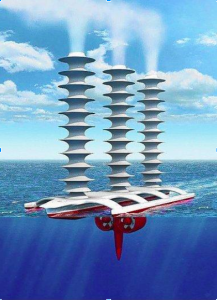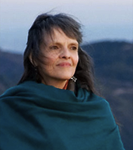 Climate Engineering No Longer Pie in the Sky
Climate Engineering No Longer Pie in the Sky
Scientists backed by the government and Bill Gates are studying schemes such as sunlight-blocking particles
This rendering [to the right] shows a cloud-brightening scheme by scientist John Latham in which a ship sprays salt particles into the air to reflect sunlight and slow global warming. (John MacNeil)
WASHINGTON — As international efforts to reduce greenhouse gas emissions stall, schemes to slow global warming using fantastical technologies once dismissed as a sideshow are getting serious consideration in Washington.
Ships that spew salt into the air to block sunlight. Mirrored satellites designed to bounce solar rays back into space. Massive “reverse” power plants that would suck carbon from the atmosphere. These are among the ideas the National Academy of Sciences has charged a panel of some of the nation’s top climate thinkers to investigate. Several agencies requested the inquiry, including the CIA. At the Jet Propulsion Laboratory in La Cañada Flintridge, scientists are modeling what such technologies might do to weather patterns. At the Pacific Northwest National Laboratory in Richland, Wash., a fund created by Microsoft founder Bill Gates — an enthusiast of research into climate engineering — helps bankroll another such effort. “There is a level of seriousness about these strategies that didn’t exist a decade ago, when it was considered just a game,” said Ken Caldeira, a scientist with the Carnegie Institution at Stanford University, who sits on the National Academy of Sciences panel. “Attitudes have changed dramatically.”
Even as the research moves forward, many scientists and government officials worry about the risks of massive climate-control contraptions. Some fear the potential for error in tampering with the world’s thermostat. Get it wrong, they say, and the consequences could be disastrous. Many also say the public could develop a false hope that geo-engineering schemes alone could halt climate change. That, they worry, would undermine already tenuous support for efforts to seriously reduce emissions of carbon dioxide and other gases that contribute to warming the climate. Even so, once-skeptical federal officials and scientists at major research institutions including Stanford, Harvard and Caltech have decided that ignoring these largely untested technologies also poses dangers. “There has been so little movement globally and, particularly, nationally toward mitigation of climate change that we’re in a situation where we need to know what the prospects are for this,” said Marcia McNutt, a former director of the U.S. Geological Survey, who is chairwoman of the National Academy of Sciences panel. “Whether we wind up using these technologies, or someone else does and we suddenly find ourselves in a geo-engineered world, we have to better understand the impacts and the consequences,” she said.
Agencies are struggling to analyze the possibilities of weather control and how it might be policed. In November, the Congressional Research Service advised lawmakers to pay attention to the issue, saying “these new technologies may become available to foreign governments and entities in the private sector to use unilaterally — without authorization from the United States government or an international treaty.” That already happened to a limited extent in mid-2012 when a California businessman, Russ George, dumped 200,000 pounds of iron-rich dust off the coast of British Columbia, Canada, in an effort — many say publicity stunt — aimed at spurring a massive plankton bloom. The theory of ocean fertilization holds that more plankton would increase the ocean’s capacity to absorb carbon from the atmosphere. George’s test did appear to cause more plankton to bloom, but it is unclear whether it had any effect on carbon dioxide levels in the air.
That same year, British scientists canceled plans to test the effect that spraying liquids at high altitude would have on sunlight. The proposed small-scale test involved launching a balloon high above the sea and spraying what would have amounted to a couple of bathtubs of water into the atmosphere. In theory, that would mimic the cooling effect that occurs when ash from a volcanic eruption blocks sunlight. The experiment was grounded amid a heated dispute, which continues today, over whether field tests should be taking place at all in the absence of international rules guiding how to go about them. Some prominent climate experts have argued that the technology the British scientists were testing, were it ever to be used on a large scale, could exacerbate extreme drought and flooding in parts of the world. “We need to consider whether we have the right legal architecture in place to make sure bad things don’t happen,” said Harvard law professor Jody Freeman, a former White House counselor for energy and climate change. “It is important we have some control and society is engaged in the risks.”
The technologies being proposed are numerous, and often odd.
“I have seen all kinds of proposals,” said James Fleming, author of “Fixing the Sky: The Checkered History of Weather and Climate Control” and a member of the National Academy geo-engineering committee. “There is a crazy new one in my email every week,” he said. “There are a lot of Rube Goldbergs out there, and some Dr. Strangeloves.” Of the technologies being considered, those that would remove carbon tend to be less controversial. Riley Duren, chief systems engineer for Earth science and technology at the Jet Propulsion Laboratory, estimates, for example, that counteracting today’s emissions would require about 30,000 of what he calls reverse power plants: enormous steel structures developed by a start-up in Calgary, Canada, that would use fans to suck carbon dioxide out of the atmosphere. The bids to redirect sunlight are much more economical and could be deployed more quickly. They also carry much more risk, the congressional research study warns. Proposals in that category include efforts at cloud whitening, in which planes or ships would shoot particles of sea salt into the sky, stimulating the formation of brighter clouds that would reflect sunlight. Other proposals would inject sulfates into the atmosphere to absorb heat, or bounce solar radiation back into space.
In addition to the danger of exacerbating drought, the congressional report warns, if such contraptions malfunctioned or were otherwise shut down, the climate could rapidly warm, “leaving little time for humans or nature to adapt.”
The authors echo the concerns of many scientists that small changes in climate over the history of Earth have been known to have severe consequences. Much of the momentum behind geo-engineering comes from an organization Gates created with Caldeira and Harvard professor David Keith. The two scientists have been getting $1.3 million annually from Gates to fund their research, as well as to distribute to other projects, such as the modeling being done at Pacific Northwest Laboratory, Caldeira said. They also hold cram sessions for the billionaire a few times each year on climate and energy issues, including geo-engineering. Caldeira and Keith hope the National Academy effort will open the way for government-sponsored field tests. But McNutt cautions that may not happen. John Latham won’t be staying idle waiting for the government to resolve that debate. A senior research scientist at the National Center for Atmospheric Research in Boulder, Colo., Latham is confident that he and his partners have developed a viable contraption. Their cloud-brightening scheme would involve ships at sea unleashing a spray of salt particles. It would use nozzles designed by Armand Neukermans, a physicist who helped invent the inkjet printer while at Hewlett-Packard. As recently as last year, the group had little hope of securing enough money to test the contraption outside the lab, Latham said. But as the buzz around geo-engineering has intensified, some wealthy individuals have stepped forward with about $1 million needed for a small-scale trial. Latham anticipates that within two or three years he will be conducting a government-sanctioned field test over thousands of acres of ocean. “People are getting more and more desperate about climate change,” he said. “I think it is quite probable we will get the OK to do this.”
Copyright © 2014, Los Angeles Times
http://www.latimes.com/nation/la-na-climate-engineering-20140305,0,3602250.story#ixzz2v9DeDWlU
